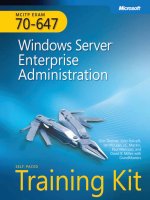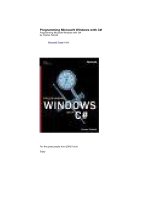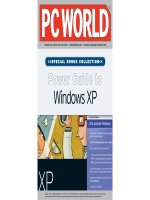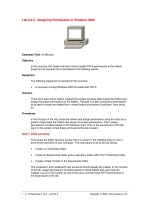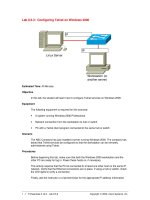Tài liệu Professional Microsoft subtitle Windows Embedded CE 6.0 pptx
Bạn đang xem bản rút gọn của tài liệu. Xem và tải ngay bản đầy đủ của tài liệu tại đây (9.85 MB, 484 trang )
Professional
Microsoft
®
Windows
®
Embedded CE 6.0
www.wrox.com
$59.99 USA
$65.99 CAN
Wrox Professional guides are planned and written by working programmers to meet the real-world needs of programmers,
developers, and IT professionals. Focused and relevant, they address the issues technology professionals face every day. They
provide examples, practical solutions, and expert education in new technologies, all designed to help programmers do a better job.
Recommended
Computer Book
Categories
Programming
Software Development
ISBN: 978-0-470-37733-8
With its support for multiple processor architectures, Windows
Embedded CE can be adapted to a variety of devices, including
Smartphones, PocketPCs, digital cameras, DVRs, VoIP, network
routers, wireless projectors, robotics, data acquisition, human-machine
interfaces, and more. Packed with straightforward exercises and helpful
examples, this book is aimed at demonstrating how to perform various
development tasks in the Windows Embedded CE 6.0 environment. You’ll
quickly come to view Windows Embedded CE 6.0 as an ideal operating
system for developing a new generation of intelligent, multimedia,
connected, and service-oriented embedded devices.
Author and Embedded CE expert Samuel Phung encourages you to
develop Windows Embedded CE 6.0 applications by adapting the skills
you already have. You’ll learn to produce a new breed of intriguing
embedded devices and you’ll come to understand ways in which the
Windows Embedded CE environment is efficient, developer-friendly, and
easy to master.
What you will learn from this book
● How to build a customized CE 6.0 runtime image
● Various forms of debugging and the array of debugging tools
● Ways to develop managed-code and native-code applications for
Windows Embedded CE using Visual Studio
Enhance Your Knowledge
Advance Your Career
● Techniques for deploying a Windows Embedded CE 6.0 device with BIOS Loader
● Methods available to autolaunch an application when CE starts
● How to create thin-client applications using the provided design templates
● Ways to customize the user interface when CE starts and replace the standard Explorer shell
Who this book is for
This book is for developers who are interested in learning what resources are available as part of the Windows Embedded CE tool
chains and how to use them. A basic understanding of Visual C++, C#, or Visual Basic is helpful.
Microsoft
®
Windows
®
Embedded CE 6.0
Phung
Professional
subtitle
spine=.96"
Updates, source code, and Wrox technical support at www.wrox.com
Professional
Microsoft
®
Windows
®
Embedded CE 6.0
Samuel Phung
Wrox Programmer to Programmer
TM
Wrox Programmer to Programmer
TM
www.it-ebooks.info
Professional
Microsoft
®
Windows
®
Embedded CE 6.0
Enhance Your Knowledge
Advance Your Career
Professional Microsoft Windows Embedded CE 6.0
978-0-470-37733-8
Provides the much needed information resources to help developers
save time and gain critical knowledge quickly to take advantage of
the Rapid-Application-Development environment provided by Windows
Embedded CE. This book reveals how different pieces of Windows
Embedded CE components come together to help programmers
develop and build devices.
Professional C# 2008
978-0-470-19137-8
Updated for .NET 3.5 and Visual Studio
®
2008, this book is the
ultimate guide to C# 2008 and its environment. The team of
superlative authors explains why the C# language cannot be viewed
in isolation, but rather must be considered in parallel with the .NET
Framework.
Professional Visual Basic 2008
978-0-470-19136-1
This book shows developers exactly how to build everything from
traditional console applications, ASP.NET applications, and XML Web
Services. Along with these various applications, this book deals with
the issues of security, data access (ADO.NET), and the latest Visual
Studio .NET IDE, as well as introducing developers to the new .NET 3.5
Framework.
Professional C++
978-0-764-57484-9
Discover how to write cross-language and cross-platform code, how
to perform unit testing and regression testing, and how to use the
standard C++ library and arm yourself with a wealth of reusable coding
patterns that can be applied to all your projects.
Get more out of
WROX.com
Programmer to Programmer
™
Interact
Take an active role online by participating in
our P2P forums
Wrox Online Library
Hundreds of our books are available online
through Books24x7.com
Wrox Blox
Download short informational pieces and
code to keep you up to date and out of
trouble!
Chapters on Demand
Purchase individual book chapters in pdf
format
Join the Community
Sign up for our free monthly newsletter at
newsletter.wrox.com
Browse
Ready for more Wrox? We have books and
e-books available on .NET, SQL Server, Java,
XML, Visual Basic, C#/ C++, and much more!
Contact Us.
We always like to get feedback from our readers. Have a book idea?
Need community support? Let us know by e-mailing
spine=.96"
www.it-ebooks.info
Professional Windows® Embedded CE 6.0
Introduction xxi
Chapter 1: Windows Embedded CE 1
Chapter 2: Development Environment and Tools 15
Chapter 3: Board Support Package 39
Chapter 4: Building a Customized CE 6.0 Runtime Image 61
Chapter 5: Connecting to Target Device 85
Chapter 6: Debugging and Debugging Tools 113
Chapter 7: Boot Loader Overview 149
Chapter 8: The Registry 163
Chapter 9: Testing with CETK 177
Chapter 10: Application Development 197
Chapter 11: Visual C# 2005 Applications 207
Chapter 12: VB 2005 Applications 223
Chapter 13: Native-Code Applications 251
Chapter 14: Autolaunch Applications 273
Chapter 15: Customizing the UI 291
Chapter 16: Thin-Client Applications 307
Chapter 17: Home Automation Applications 327
Chapter 18: RFID Security Access Control Applications 361
Chapter 19: Robotic Applications 371
Chapter 20: Deploying a CE 6.0 Device 397
Appendix A: Windows Embedded CE References 417
Appendix B: Installation and Software 423
Appendix C: Sample Applications and OS Design Projects 427
Index 435
ffirs.indd iffirs.indd i 9/26/08 5:37:44 PM9/26/08 5:37:44 PM
www.it-ebooks.info
ffirs.indd iiffirs.indd ii 9/26/08 5:37:45 PM9/26/08 5:37:45 PM
www.it-ebooks.info
Professional
Windows® Embedded CE 6.0
ffirs.indd iiiffirs.indd iii 9/26/08 5:37:45 PM9/26/08 5:37:45 PM
www.it-ebooks.info
ffirs.indd ivffirs.indd iv 9/26/08 5:37:45 PM9/26/08 5:37:45 PM
www.it-ebooks.info
Wiley Publishing, Inc.
Professional
Windows® Embedded CE 6.0
Samuel Phung
ffirs.indd vffirs.indd v 9/26/08 5:37:45 PM9/26/08 5:37:45 PM
www.it-ebooks.info
Professional Windows® Embedded CE 6.0
Published by
Wiley Publishing, Inc.
10475 Crosspoint Boulevard
Indianapolis, IN 46256
www.wiley.com
Copyright © 2009 by Wiley Publishing, Inc., Indianapolis, Indiana
Published simultaneously in Canada
ISBN: 978-0-470-37733-8
Manufactured in the United States of America
10 9 8 7 6 5 4 3 2 1
Library of Congress Cataloging-in-Publication Data
Phung, Samuel, 1960-
Professional Windows embedded CE 6.0 / Samuel Phung.
p. cm.
Includes index.
ISBN 978-0-470-37733-8 (paper/website)
1. Embedded computer systems—Programming. 2. Real-time data processing. 3. Microsoft
Windows (Computer file) I. Title.
TK7895.E42P49 2008
005.26—dc22
2008037338
No part of this publication may be reproduced, stored in a retrieval system or transmitted in any form or
by any means, electronic, mechanical, photocopying, recording, scanning or otherwise, except as permitted
under Sections 107 or 108 of the 1976 United States Copyright Act, without either the prior written
permission of the Publisher, or authorization through payment of the appropriate per-copy fee to the
Copyright Clearance Center, 222 Rosewood Drive, Danvers, MA 01923, (978) 750-8400, fax (978) 646-8600.
Requests to the Publisher for permission should be addressed to the Legal Department, Wiley Publishing,
Inc., 10475 Crosspoint Blvd., Indianapolis, IN 46256, (317) 572-3447, fax (317) 572-4355, or online at
/>Limit of Liability/Disclaimer of Warranty: The publisher and the author make no representations or
warranties with respect to the accuracy or completeness of the contents of this work and specifically
disclaim all warranties, including without limitation warranties of fitness for a particular purpose. No
warranty may be created or extended by sales or promotional materials. The advice and strategies contained
herein may not be suitable for every situation. This work is sold with the understanding that the publisher
is not engaged in rendering legal, accounting, or other professional services. If professional assistance is
required, the services of a competent professional person should be sought. Neither the publisher nor the
author shall be liable for damages arising herefrom. The fact that an organization or web site is referred to in
this work as a citation and/or a potential source of further information does not mean that the author or the
publisher endorses the information the organization or web site may provide or recommendations it may
make. Further, readers should be aware that Internet web sites listed in this work may have changed or
disappeared between when this work was written and when it is read.
For general information on our other products and services, please contact our Customer Care Department
within the United States at (800) 762-2974, outside the United States at (317) 572-3993 or fax (317) 572-4002.
Trademarks: Wiley, the Wiley logo, Wrox, the Wrox logo, Wrox Programmer to Programmer, and related trade
dress are trademarks or registered trademarks of John Wiley & Sons, Inc. and/or its affiliates, in the United States
and other countries, and may not be used without written permission. Windows is a registered trademark of
Microsoft Corporation in the United States and/or other countries. All other trademarks are the property of their
respective owners. Wiley Publishing, Inc., is not associated with any product or vendor mentioned in this book.
Wiley also publishes its books in a variety of electronic formats. Some content that appears in print may not
be available in electronic books.
ffirs.indd viffirs.indd vi 9/26/08 5:37:45 PM9/26/08 5:37:45 PM
www.it-ebooks.info
About the Author
Samuel Phung has worked for more than 20 years in both the hardware and software areas of the
computer industry. In the late 1980s, he worked for computer hardware companies. In the early 1990s,
he led a financial database software development team, developing software for the banking industry.
Later he led a software team developing Windows - based telephony applications for a venture
capital - funded startup. In the late 1990s, he became engaged with the Windows Embedded product
team, starting with Windows NT 4.0 Embedded. He has been working with Windows Embedded CE
since version 2.12 was introduced.
He currently works for ICOP Technology, Inc., in El Monte, California, where he is responsible for
strategic business development for the North American region. Among his Windows Embedded
activities is initiating ICOP local - language web sites supporting the Taiwan, China, and Japan regions.
He also maintains a personal web site,
www.embeddedpc.net , to provide Windows Embedded
information resources for new developers.
Phung graduated from California State University Long Beach (CSULB) in 1984 with an EE degree.
About the Technical Editors
Todd Meister has been developing using Microsoft technologies for more than 10 years. He ’ s been
a technical editor on more than 50 titles ranging from SQL Server to the .NET Framework. He is an assistant
director for computing services at Ball State University in Muncie, Indiana. He and his wife, Kimberly, live
in central Indiana with their four children. Contact Todd at .
Dan Francis has been working professionally in software development since he was 15 and is currently a
software engineering manager for a Fortune 50 company. He lives with his wife and twin daughters in
northern Maryland. Contact Dan at .
ffirs.indd viiffirs.indd vii 9/26/08 5:37:46 PM9/26/08 5:37:46 PM
www.it-ebooks.info
ffirs.indd viiiffirs.indd viii 9/26/08 5:37:46 PM9/26/08 5:37:46 PM
www.it-ebooks.info
Credits
Acquisitions Editor
Katie Mohr
Development Editors
William Bridges
Tom Dinse
Technical Editors
Todd Meister
Daniel Francis
Production Editor
Kathleen Wisor
Copy Editor
Cate Caffrey
Editorial Manager
Mary Beth Wakefield
Production Manager
Tim Tate
Vice President and
Executive Group Publisher
Richard Swadley
Vice President and Executive Publisher
Joseph B. Wikert
Project Coordinator, Cover
Lynsey Stratford
Proofreader
Publication Services , Inc.
Indexer
Robert Swanson
ffirs.indd ixffirs.indd ix 9/26/08 5:37:46 PM9/26/08 5:37:46 PM
www.it-ebooks.info
ffirs.indd xffirs.indd x 9/26/08 5:37:46 PM9/26/08 5:37:46 PM
www.it-ebooks.info
Acknowledgments
Going through the experience of writing a book for the first time has helped me realize the amount of
work, effort, and support needed to get a book to print. I could not have done it without the supporting
team working behind the scenes to help me.
First, I thank Sondra Webber at Microsoft and Katie Mohr at Wiley for making this book possible. I thank
William Bridges at Wiley for reviewing my writing, providing valuable input, and helping correct many
of the mistakes I made. I thank Todd Meister and Dan Francis for reviewing the technical contents.
Without the hard work of the Windows Embedded team at Microsoft, the Windows Embedded CE
product would not be where it is today. My thanks to Mike Hall, Susan Loh, Gabriel Spil, Travis Hobrla,
Riki June, and the Windows Embedded CE development team for posting useful information and
answering my questions over the years. I also recognize James Y. Wilson, Avi Kcholi, Steve Maillet, Chris
Tacke, Alex Feinman, Maarten Struys, David Heil, Bill Ma, Richard Lee, Paul Yao, Paul Tobey, Douglas
Boling, and other Windows Embedded MVPs who contributed their time and knowledge to the news
group and posted a large pool of technical resources online to benefit others. The base provided by
this group of MVPs helped me gain valuable knowledge and resolved countless problems.
I also thank the following individuals who went out of their way and provided help beyond what was
expected:
Ratheesh Rajan with the Windows Embedded CE BSP team
Jason Summerour from Robotics Connection
Chester Fitchett and Don Ha from Phidgets, Inc.
Most of all, I thank my wife, Ann, for her understanding, patience, and support while I took time away
from the family to work on the book.
ffirs.indd xiffirs.indd xi 9/26/08 5:37:46 PM9/26/08 5:37:46 PM
www.it-ebooks.info
ffirs.indd xiiffirs.indd xii 9/26/08 5:37:46 PM9/26/08 5:37:46 PM
www.it-ebooks.info
Contents
Introduction xxi
Chapter 1: Windows Embedded CE 1
What Is Embedded? 1
Embedded Devices 1
Embedded Software 2
Embedded Devices and Software 3
The Windows Embedded Family 3
Windows XP Embedded 4
Windows Embedded Point of Service 4
Windows Embedded CE 6.0 4
Modular and Compact OS 5
Real-Time Operating System 6
Supported Hardware 6
New Features in CE 6.0 R2 7
Customizable UI 8
Wired and Wireless Connectivity 8
Graphics and Multimedia 9
Multilanguage, International Localization 9
Real-Time Communication and VoIP 10
OS Design Templates 11
Developing CE Applications 12
Testing and Debugging 12
What Can Windows Embedded CE Do? 13
Summary 14
Chapter 2: Development Environment and Tools 15
Windows Embedded CE Platform Builder 15
Windows Embedded CE 6.0 Installation 16
Supported Processors 17
Installation Sequence 18
Quick Fix Engineering and Update 19
Windows Embedded CE Terminology 20
Windows Embedded CE Environment Variables 23
ftoc.indd xiiiftoc.indd xiii 9/26/08 5:38:54 PM9/26/08 5:38:54 PM
www.it-ebooks.info
Contents
xiv
Windows Embedded CE Files and Directories 32
Third-Party Components 35
Building CE Runtime Images 35
Summary 37
Chapter 3: Board Support Package 39
BSP Overview 39
BSP Development 42
Cloning the Device Emulator BSP 43
Cloning the CEPC BSP 44
Cloning the ICOP_eBox4300_60E BSP 52
BSP Components, Files, and Folders 53
Adding Files and Modules to the BSP 58
Summary 60
Chapter 4: Building a Customized CE 6.0 Runtime Image 61
Creating the Initial OS Design 62
The OS Design Wizard 63
OS Design Project Folders and Files 69
OS Design Project View from VS2005 IDE 70
Generating the OS Runtime Image 76
OS Runtime Image for MyCEPCBSP 78
OS Runtime Image for MyeBox4300BSP 80
Summary 83
Chapter 5: Connecting to Target Device 85
Target Device Connectivity 85
Connecting to Emulator 86
Creating the MyEmulator Target Device Profile 86
Configuring the MyEmulator Target Device Settings 88
Downloading Runtime Image to the Emulator 90
Connecting to eBox-4300-MSJK 91
Connecting to eBox-4300-MSJK with DHCP 92
Connecting to eBox-4300-MSJK with Static IP 99
Connecting to the CEPC 105
Creating the CEPC Boot Floppy Disk 105
Connecting to CEPC with the Serial Port 110
Connecting to CEPC with Ethernet 112
Summary 112
ftoc.indd xivftoc.indd xiv 9/26/08 5:38:55 PM9/26/08 5:38:55 PM
www.it-ebooks.info
Contents
xv
Chapter 6: Debugging and Debugging Tools 113
Debugging Environment 114
CETK 114
CoreCon 114
Debugging and Release Configuration 114
Debugging the OS Design Build 115
The CE Build Process 116
Build Error — Missing File 116
Remote Tools 120
Remote File Viewer 121
Remote Heap Walker 124
Remote Zoom-In 126
Remote Process Viewer 127
Remote Registry Editor 129
Remote System Information 132
Remote Performance Monitor 132
Remote Spy 135
Remote Kernel Tracker 138
Remote Call Profiler 140
Remote Target Control 141
Serial Debug 144
Summary 147
Chapter 7: Boot Loader Overview 149
What Is a Boot Loader? 149
BIOS Loader–x86 BIOS Loader 150
E boot Loader 150
Loadcepc 151
Romboot Loader 152
Sboot Loader 152
BIOS Loader for x86 Devices 152
x86 Device Boot Process 152
BIOS Loader Code 153
Building the BIOS Loader Code 154
Summary 162
Chapter 8: The Registry 163
Windows Embedded CE Registry 163
RAM-Based Registry 165
Hive-Based Registry 165
ftoc.indd xvftoc.indd xv 9/26/08 5:38:55 PM9/26/08 5:38:55 PM
www.it-ebooks.info
Contents
xvi
Hive-Based Registry Triggers Two Boot Phases 166
Persistent Registry with Hive-Based Registry 166
Registry Flushing 169
Windows Embedded CE Registry Files 170
Registry for Windows Embedded CE Components 170
Serial Debugging 173
Useful Registry References 175
Auto-Flush and Save Registry Settings 175
Device Name for USB Removable Storage 175
Disable Suspend from the Start Menu 175
Internet Explorer Startup Page 175
Static IP Address 175
Windows Embedded CE Device Name 176
Accessing the Registry 176
Summary 176
Chapter 9: Testing with CETK 177
Windows Embedded CE Test Kit 177
CETK Tests 178
Connecting to CETK with KITL and Platform Manager 179
Connecting CETK to Target Device Using Sockets 188
Summary 196
Chapter 10: Application Development 197
The Development Landscape 198
The Desktop Windows Development Environment 199
The CE Development Environment 199
The .NET Compact Framework 202
Other Third-Party Libraries 204
New Breed of Embedded Devices 204
Summary 205
Chapter 11: Visual C# 2005 Applications 207
Developing C# Applications for CE 207
Configuring and Building the Runtime Image 208
Downloading the Runtime Image to the Emulator 211
Creating the C# Smart Device Application Project 212
Adding Controls to the Application 213
Adding Codes to the Application 214
Connecting to the Target Device 214
ftoc.indd xviftoc.indd xvi 9/26/08 5:38:55 PM9/26/08 5:38:55 PM
www.it-ebooks.info
Contents
xvii
Deploying C# Application to Target Device 219
Debugging the C# Application on Target Device 220
Summary 222
Chapter 12: VB 2005 Applications 223
Developing VB Applications for CE 224
Configuring and Building the Runtime Image 224
Establishing a Connection to the eBox-4300 229
Downloading Runtime Image to eBox-4300 233
Creating a VB 2005 Smart Device Application 234
Establishing a Connection to the eBox-4300 242
Deploying the SerialPortApp to the eBox-4300 246
Testing the SerialPortApp on the eBox-4300 247
Summary 249
Chapter 13: Native-Code Applications 251
Visual C++ 2005 Native Applications 251
The Autolaunch Component 252
Configuring and Building the Runtime Image 254
Configuring and Building an SDK 258
Downloading a Runtime Image to the Emulator 259
Creating the Visual C++ 2005 Smart Device Application 261
Connecting to the Emulator with CoreCon 263
Deploying Visual C++ 2005 Application to the Emulator 266
Platform Builder Native Application 266
CE Subproject Wizard 266
Deploying the PBNativeApp Application 269
Summary 271
Chapter 14: Autolaunch Applications 273
Autolaunch with the Registry 273
Autolaunch with Windows\Startup 276
The AutoLaunchApp Utility 280
Summary 290
Chapter 15: Customizing the UI 291
Input and Output for the CE Device 292
The Input 292
The Output 293
ftoc.indd xviiftoc.indd xvii 9/26/08 5:38:56 PM9/26/08 5:38:56 PM
www.it-ebooks.info
Contents
xviii
Custom UI for the CE 294
CE with NMD Custom UI 295
VB 2005 Application as the Custom UI 300
Configure the OS Design for Testing 300
Develop the VB 2005 Application 301
Add the VB 2005 Application to the OS Design 304
Summary 306
Chapter 16: Thin-Client Applications 307
The Thin-Client Terminal 307
The Windows Thin Client OS 308
The Initial WTC OS Design 309
Configuring a Target Device and Downloading an Image 311
Customizing the WTC OS Design 313
The Autolaunch Subproject 316
Disabling the Explorer Shell 323
Summary 326
Chapter 17: Home Automation Applications 327
Home Automation Control 327
Control Applications 329
Controllers, Relays, Switches, and Sensors 330
Hardware and Peripherals 330
The eBox-4300-MSJK 330
Phidget Devices 331
BSP and Software Library 335
Electronic 101 for Input and Output 336
The eBoxPhidget OS Design 337
Development Environment 337
Creating the OS Design 338
Additional Needed Components 339
Configuring the Registry 339
Configuring the Build Option and Build 340
Target Device Connectivity and Download 341
Configuring and Generating the SDK 343
Installing the eBoxPhidgetSDK 343
Home Automation Applications 343
Temperature Sensor Application 343
Preparing eBox-4300-MSJK for Application Deployment 348
Remote Display Application 350
ftoc.indd xviiiftoc.indd xviii 9/26/08 5:38:56 PM9/26/08 5:38:56 PM
www.it-ebooks.info
Contents
xix
Deploying Applications to eBox-4300-MSJK 351
Phidget Relay Switching Application 356
Other Phidget Sensors 357
Summary 360
Chapter 18: RFID Security Access Control Applications 361
Radio Frequency Identification — RFID 361
The PhidgetRFID Reader 362
RFID Reader Applications 362
Hardware Component for the Application 362
Software Component for the Application 363
Creating the RFIDApp 363
Summary 370
Chapter 19: Robotic Applications 371
The Stinger CE Robot 371
The Serializer WL Robot Controller 373
How Does the Serializer Work? 374
Simple Robotic Control Applications 375
Windows Embedded CE Design 375
Robotic Application Using the Serial Port Class 375
Source Code Listing for SerialPortClass Project 383
Robotic Application Using the Serializer .NET Library 387
Launching the Robotic Application 393
Configuring the OS Design for SerialPortClass Application 393
Launching serialportclass.exe on the Stinger CE Robot 394
Configuring the OS Design for SerializerNET Application 394
Launching serializernet.exe on the Stinger CE Robot 395
Summary 395
Chapter 20: Deploying a CE 6.0 Device 397
Windows Network Projector 398
Windows Network Projector OS Design 399
Creating the Initial OS Design 399
Configuring, Customizing, and Building the OS Design 400
Target Connectivity and OS Image Download 401
Cloning the Pictor Application 402
Configuring to Boot from BIOS Loader 409
Windows Network Projector Usage 415
Summary 416
ftoc.indd xixftoc.indd xix 9/26/08 5:38:56 PM9/26/08 5:38:56 PM
www.it-ebooks.info
Contents
xx
Appendix A: Windows Embedded CE References 417
Appendix B: Installation and Software 423
Appendix C: Sample Applications and OS Design Projects 427
Index 435
ftoc.indd xxftoc.indd xx 9/26/08 5:38:56 PM9/26/08 5:38:56 PM
www.it-ebooks.info
Introduction
Windows Embedded CE is a 32 - bit, native, hard, real - time, small - footprint operating system developed
by Microsoft to address the needs of handheld, mobile, and embedded devices. With support for
multiple processor architectures, Windows Embedded CE can be adapted to a variety of devices like
Smartphones, PocketPCs, set - top boxes, thin - client terminals, digital cameras, DVRs, VoIP, point - of - sale,
point - of - information, network routers, wireless projectors, industrial automation, home and building
automation, robotics, data acquisition, and human – machine interfaces.
In today ’ s fast - paced, unforgiving technology market, rapid application development, fast time - to -
market, manageable development risks, and cost are key factors contributing to the success of any
product development project. With its low - cost licenses, along with the developer - friendly Visual Studio
environment and large pool of professional Visual Studio developers, Windows Embedded CE is an
attractive operating system for developing a new generation of intelligent, multimedia, connected, and
service - oriented embedded devices.
Views differ on likely market size and opportunities for Windows Embedded CE technology. While
some CE - enabled products have strong visibility, such as the Windows Mobile Smartphone, Pocket PC,
GPS navigation device, Zune media player, and Windows CE Thin Client terminal, many other devices
are not visible to end - users, even though they may be using the devices daily. These devices are built to
provide a set of designated functions, such as test instrument, data acquisition device, industrial
automation controller, digital video recorder, printer, human – machine interface terminal, self - serve
kiosk, and multimedia appliance. The companies building these devices use the Windows Embedded CE
kernel technology and develop their own applications and appropriate user interfaces for the particular
device. When the device powers on, it displays a splash screen with information to identify the device
and the company while booting. After the boot process is completed, the device displays the
application ’ s user interface, specifically designed for the device.
In the past, when referring to embedded development, many developers were thinking of low - cost 8 - bit
and 16 - bit microcontrollers, with limited functionality, requiring the use of low - level, difficult - to - master
programming languages and a user - unfriendly development environment. Rapidly evolving silicon
technology, delivering faster and smaller processors, makes it possible to build smaller - footprint
embedded controllers with faster processors while lowering the cost.
A new generation of 32 - bit, high - performance, low - power, and small - footprint computing hardware is
now readily available at low cost. These, coupled with Windows Embedded CE, provide the platform to
develop a new breed of products. Companies can develop new products with additional features while
lowering development time, maintenance, and product cost. This has changed the development
landscape for the embedded - device market by enabling the Visual Studio developer, using Visual Basic,
Visual C++, or C#, to develop new kinds of embedded devices. Embedded development is tightly
coupled with writing software code and developing or finding appropriate hardware. The growing
availability of embedded hardware, with support for Windows Embedded CE, helps expand the market
and opportunities for CE.
Here are some of the new 32 - bit embedded controllers built with the Vortex86 family of x86 processors,
with costs ranging from under $ 100 to $ 200.
flast.indd xxiflast.indd xxi 9/26/08 5:38:21 PM9/26/08 5:38:21 PM
www.it-ebooks.info
Introduction
xxii
The Vortex86SX - 6117 (shown in Figure I - 1 ) is an embedded controller, built with a 300 - MHz x86
processor, 128 MB RAM, 10/100 Mbps Ethernet, USB 2.0, RS - 232, 16 - bit GPIO, 2 MB SPI flash to emulate
bootable floppy drive, and IDE interface to support bootable IDE flash storage. This embedded
controller requires +5 V DC and 240 mA to operate, measures 1.96 × 3.14 inches, and costs less than $ 100.
Figure I-1
The Vortex86SX - 6115 (Figure I - 2 ) is an embedded controller, built with a 300 - MHz x86 processor, 128 MB
RAM, 10/100 Mbps Ethernet, two USB 2.0 host interfaces, three RS - 232 serial ports, one RS - 232/485
serial port, parallel port, 16 - bit GPIO, 2 MB SPI flash to emulate bootable floppy drive, and IDE interface
to support bootable IDE flash storage. This embedded controller requires +5 V DC and 360 mA to
operate, measures 2.6 × 3.94 inches, and costs less than $ 150.
Figure I-2
flast.indd xxiiflast.indd xxii 9/26/08 5:38:22 PM9/26/08 5:38:22 PM
www.it-ebooks.info
Introduction
xxiii
The Vortex86SX - 6150E (Figure I - 3 ) is an embedded controller in PC/104 format, built with a 300 - MHz
x86 processor, 128 MB RAM, 10/100 Mbps Ethernet, USB 2.0, RS - 232, 16 - bit GPIO, 2 MB SPI flash to
emulate bootable floppy drive, and IDE interface to support bootable IDE flash storage. This embedded
controller requires +5 V DC and 360 mA to operate, measures 3.54 × 3.77 inches, and costs less than $ 150.
The PDX - 057T (Figure I - 4 ) is a compact industrial panel PC with a 5.7 - inch touch screen, providing
640 × 480 VGA display resolution. It ’ s powered by a 600 - MHz Vortex86DX processor with 256 MB RAM,
integrated 10/100 Mbps Ethernet, USB 2.0, RS - 232, Compact Flash, and Ultra - DMA IDE. This device
measures 5.98 × 4.41 × 1.3 inches and requires +5 V DC at 1.04 A to operate.
Figure I-3
Figure I-4
flast.indd xxiiiflast.indd xxiii 9/26/08 5:38:23 PM9/26/08 5:38:23 PM
www.it-ebooks.info
